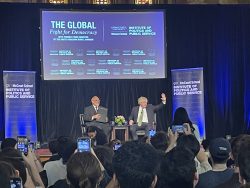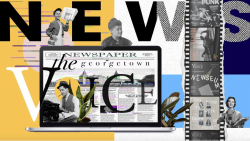In the weeks after Hurricane Katrina, a group of tech-savvy citizens created the Katrina People Finder, a website that helps family members of New Orleans residents locate their loved ones. The project suffered from mass input problems as millions of e-mails flowed into the server until an anonymous good samaritan corrected the problem. When the organization contacted him and asked how he did it, he said he would have to tell them after school, because at the time, his mom was telling him he had to leave.
“Clearly, these projects harnessed the best of the most unexpected people,” Howard Rheingold, author of Smart Mobs: The Next Social Revolution, said in McShain Lounge on Monday. Rheingold, who is a professor at the University of California at Berkeley and Stanford University, explained how technology is “changing the way humans get things done together.”
Rheingold spoke emphatically about project after project in which technology has enabled otherwise unconnected individuals to collaborate and make enormous accomplishments, such as Wikipedia.


Rheingold’s eyes bulged with excitement as he described how text messaging allowed citizens of the Philippines to organize instant political protests against President Joseph Estrada that ultimately forced him to resign.
“If you think about where we’re headed today,” he said, “we can do things we never thought possible before.”
Another story he told was that of the SETI project, in which, according to Rheingold, nearly two million people have volunteered to run algorithms on their personal computers analyzing radio signals from outer space in hopes of discovering extraterrestrial life.
“But it’s not just about looking for little purple people in space,” he said.
“I really liked how he looked back at history and continued to think about it as he talked about technology for the future,” Katie Morrissey, a graduate student in the CCT program, said.
Despite Rheingold’s enthusiasm, students and professors alike raised questions about the dangers of technology during the question and answer session that followed his speech. Asked about the looming possibility of making surveillance footage from security cameras available online, Rheingold acknowledged the dangerous potential technology and collective action have together.
“Humans do ugly things together,” he said. “I call my book Smart Mobs for a reason.”




